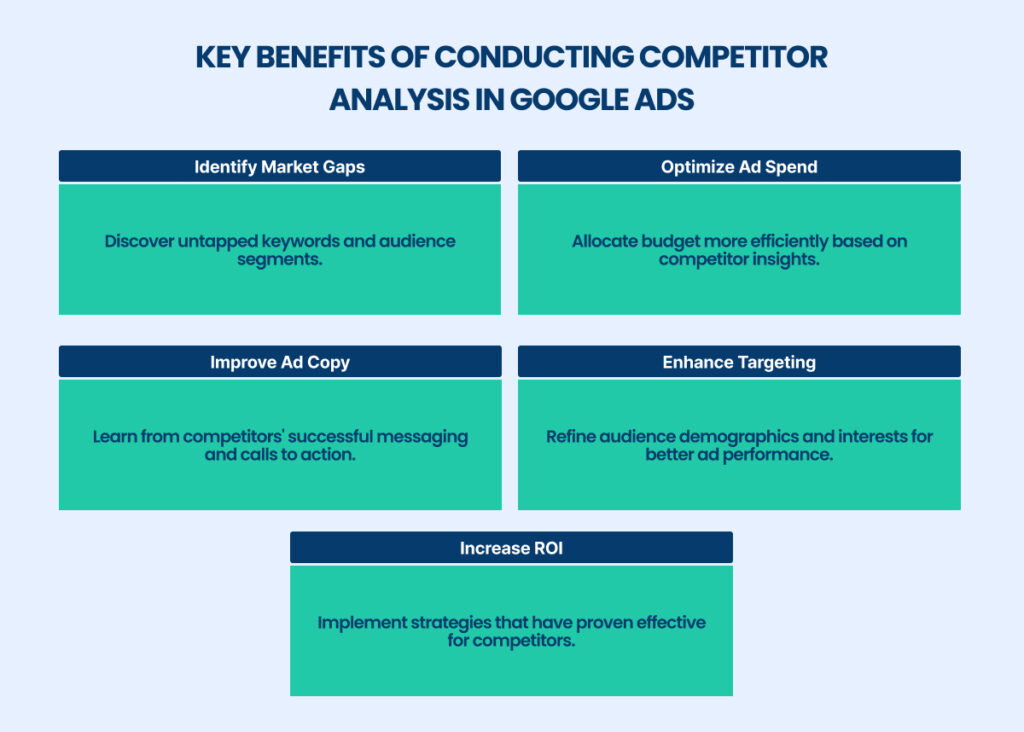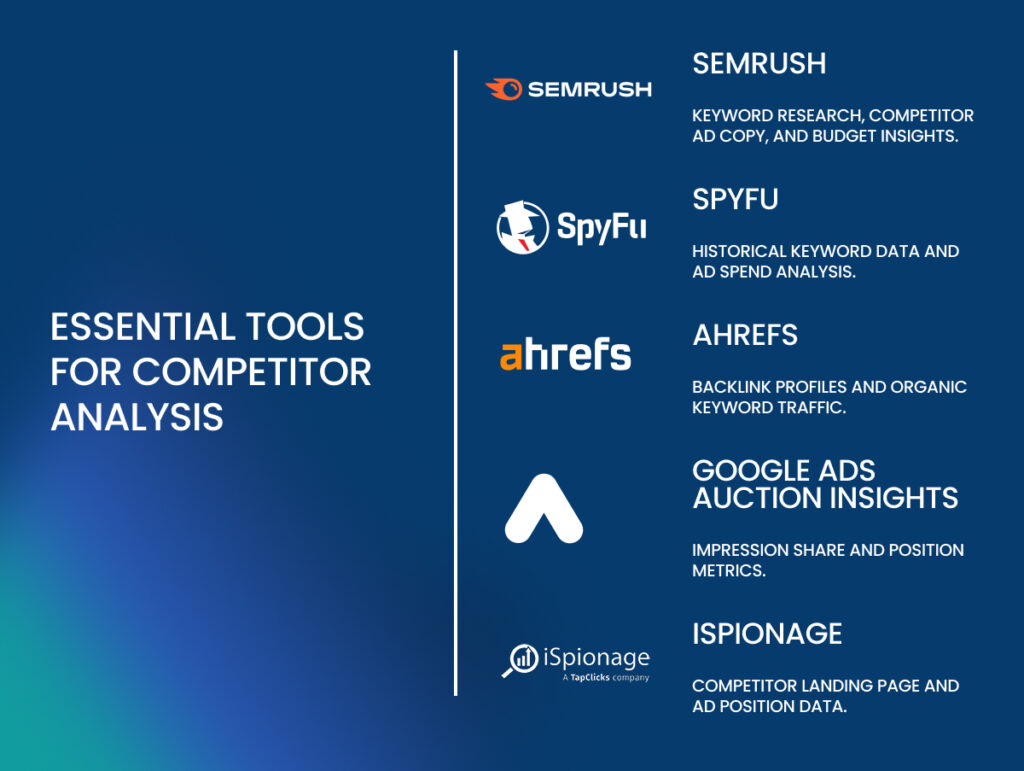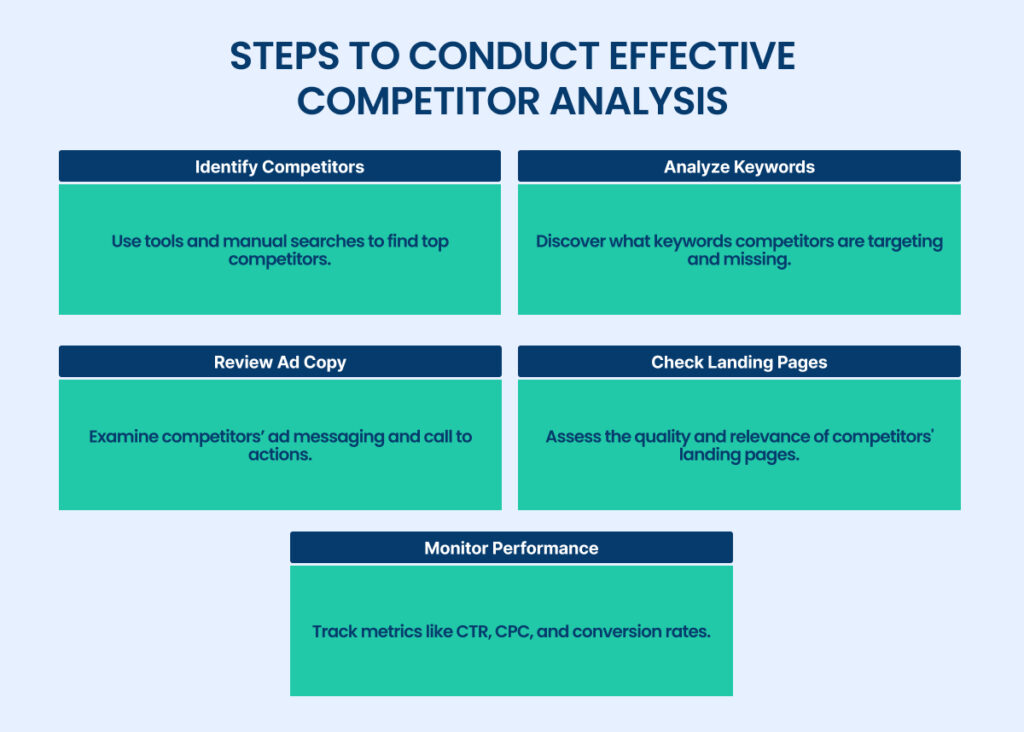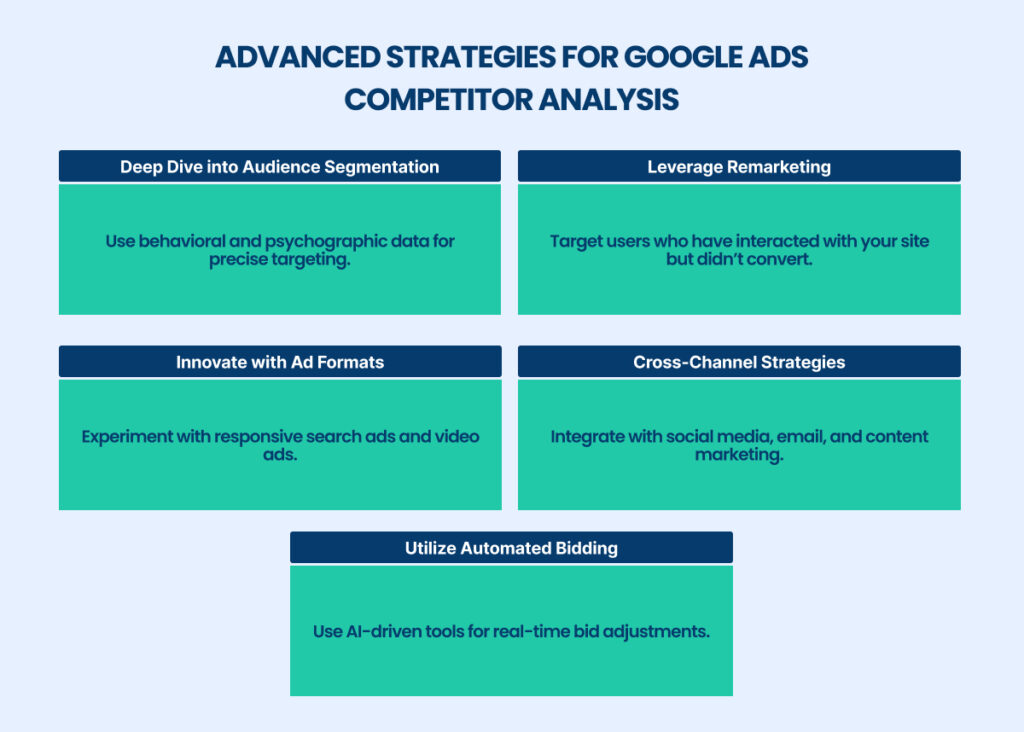In the fast-paced digital marketplace, businesses must continuously seek ways to stand out and engage with their target audience.
A crucial component of this effort is conducting a Google Ads competitor analysis, allowing you to understand how your competitors position themselves in the ad space.
This process involves examining the keywords your competitors are targeting, the content of their ads, and their bidding strategies.
By performing a thorough Google Ads competitor analysis, you will be able to conclude all the Google Ads competitor analysis you conduct, which, in turn, will enable you to improve your campaigns, thus ensuring that you succeed in winning over the attention of your audience.
A deal with a market player like Google Ads Agency becomes the best for the more efficient businesses that wish to get the most out of their actions.
In addition to the expert assistance you receive from such firms, your campaigns will be more competitive and have a more significant impact.
Using the information acquired from competitor Google Ads analysis, you can make choices supported by the data, achieving better performance and a higher return rate on investment.
This article will explore the key metrics, tools, and techniques for conducting a comprehensive Google Ads competitor analysis. It will equip you to stay ahead of the competition and achieve your business objectives.
Understanding Competitor Analysis in Google Ads
Raising a Google Ads com competitor analysis is very important for companies aiming to enhance their digital marketing strategies. This report tells you the tactics your competitors are taking and keeps you on your toes to add a new approach.
Critical Components of Google Ads Competitor Analysis:
- Evaluating Competitor Campaigns: Examine rivals’ Google Ads campaigns to develop the information that will indicate the ability to target keywords, ad placements, and bidding strategies. Identify which keywords are working better and driving traffic and conversions for them, evaluate how well their campaign structure is doing, and confirm its effectiveness.
- Analyze competitors’ Google Ads campaigns to gain insights into their keyword targeting, ad placements, and bidding strategies.
- Understand which keywords drive traffic and conversions for them and evaluate the campaign structure.
- Uncovering Market Opportunities: You may also find niche, low-volume terms or phrases by scanning through the info into your competitor’s most-loved and used keywords that may no longer be relevant. Therefore, you must bring to the table new ones or information your competitors may have evaded or not been aware of.
By examining competitors’ targeted keywords, you learn new ways to uncover or underuse the few opportunities that come your way. - Identify niche keywords and specific audience segments that your competitors might be overlooking. This will allow you to capture a market share they must fully address.
- A thorough Ad Campaign Structure Understanding: Analyze rival brands’ ad copies, landing pages, CTA tactics, and overall messaging. Study their success stories and be ready to avoid their flaws, bringing you to the art and science of creating more persuasive communication materials.
- Examine competitors’ ad copy, landing pages, call-to-action strategies, and overall messaging.
- Learn from their success stories and prevent repeating their errors. You can develop ads that influence your market more deeply and meaningfully.
- Tools and Data Utilization: Run tools like Google Ads Auction Insights to get pieces of information that are critical for deciding whether to bid or what terms to bid on, impression share, average position, and overlap rate being just a few examples.
This information paints a visible picture of how your industry is doing in the competitive market. Then, you steer your strategies along paths to help your business perform better and be more visible. - Improving Audience Targeting: Check especially for the features of the people that your foe addresses. Discover their favorite places, ages, interests, or other information they use in their Google Ads campaign. Use these data to make your targeting group more competitive with the ones you aim at; for example, make them as relevant and convertible as possible.
- Demographic details: To determine which competitors are focusing on in terms of locations, interests, and behaviors in their Google Ads campaigns.

With the help of this knowledge, narrow down your target audience correctly. Thus, your ads will appear on the most appropriate and high-selling clients.
Essential Tools for Competitor Analysis
To execute a practical Google Ads competitor analysis, it is important to use the right tools to provide comprehensive insights into your competitors’ strategies.
These tools help you analyze keywords, ad copy, and other critical components of your competitors’ ads, enabling you to refine your Google Ads strategy.
Google Ads Auction Insights
Google Ads Auction Insights is a powerful tool that offers data on how your ads perform compared to your competitors’ ads. It provides metrics such as impression share, average position, and overlap rate, allowing you to understand where your campaigns stand in the competitive landscape. This tool helps you identify areas where you can improve your ads to gain a competitive edge.
SEMrush
SEMrush is a professional tool that offers a detailed analysis of your competitors’ ads. It provides:
- Data on the paid keywords they are targeting.
- The cost per click (CPC).
- Their estimated ad spend.
Additionally, SEMrush offers insights into competitors’ ad copy and landing pages, helping you refine your strategies and improve your ad performance.
SpyFu
SpyFu specializes in uncovering the Google Ads keyword planner data used by competitors. It shows the exact keywords your competitors are bidding on and how much they spend on each.
This tool also provides historical data, allowing you to trail changes in your competitors’ strategies over time. According to a recent study understanding competitors’ keyword strategies can significantly increase ad efficiency and ROI.
Ahrefs
Ahrefs is another essential tool for conducting a competitor Google Ads analysis. It offers insights into the backlink profiles of your competitors’ websites, helping you understand their off-site SEO strategies.
Additionally, Ahrefs provides data on the Google search results and organic keywords that drive traffic to your competitors’ sites, which can inform your SEO and SEM strategies.
Google Ads Keyword Planner
Google Ads Keyword Planner is fundamental for keyword research and competitive analysis. It helps you discover new keyword opportunities and estimate their potential traffic and costs.
This tool is handy for identifying paid keywords your competitors are trying to target, allowing you to refine your Google Ads strategy to capture a larger market share.
iSpionage
iSpionage provides insights into competitor ads and landing pages, allowing you to see how your competitors position their products and services.
It also offers data on the average ad position and click-through rates (CTR) for specific keywords, helping you with measuring the effectiveness of your campaigns in comparison.

By leveraging these tools, you as a business owner can conduct a thorough Google Ads competitor analysis, picking up valuable insights about their competitors’ strategies and tactics.
This knowledge enables you to refine your Google Ads strategy, optimize your campaigns, and achieve better results. Using these insights effectively can help you stay ahead in a competitive digital marketplace.
Techniques for Effective Competitor Analysis
Here are some effective techniques to gain insights and optimize your advertising efforts:
Identify Key Competitors
Begin by identifying your top Google Ads competitors. This involves looking at businesses that consistently appear in your ad spaces. Tools like the Google Ads Transparency Center can help you find and analyze competitors by providing detailed insights into ad placements and history.
Analyze Competitor Keywords
Knowing the keywords that your competitors target is necessary. Use tools like Google Ads Keyword Planner to uncover your competitors’ primary keywords. This analysis helps with identifying gaps in the market and opportunities for you to capitalize on underutilized keywords. Additionally, focusing on negative keywords can prevent your ads from appearing in irrelevant searches, thereby improving the quality of your traffic.
Evaluate Ad Copy and Creative
Review the ad copy and creative details used in competitors’ Google Ads. Analyze how they structure their messaging, the offers they highlight, and their calls to action. This can inspire refining your own ad copy to be more compelling and differentiate your offerings.
Monitor Competitor Landing Pages
Examine the landing pages used by your Google Ads competitors. Assess the user experience, content quality, and conversion elements like forms and calls to action. This can offer insights into what works well and areas where you can improve your own landing pages to enhance conversion rates.
Leverage Google Ads Auction Insights
Use the Google Ads Auction Insights report to understand how your ads perform relative to your competitors. This tool provides data on impression share, average position, and top-of-page rate, which are critical for identifying how your ads rank.
Track Competitor Budget and Bidding Strategies
Understanding your competitors’ budgets and bidding strategies is key to Google Ads competitive analysis. Tools like SEMrush or SpyFu can offer estimates of competitors’ ad spend, which can help you adjust your budget and bidding strategies to stay competitive.
Utilize Competitive Analysis Tools
Leverage specialized tools for comprehensive competitor analysis. Platforms like Ahrefs, iSpionage, and Moz provide valuable data on keyword rankings, backlinks, and overall SEO health, which can be instrumental in shaping your own Google Ads campaigns.

By employing these techniques, businesses can conduct a robust Google Ads competitor analysis, gaining invaluable insights into their competitors’ strategies and tactics.
This not only helps in optimizing their own ads but also ensures that they remain competitive in the ever-evolving digital marketplace.
Advanced Strategies for Staying Ahead of Google Ads Competition
In 2023, Google’s advertising revenue reached $237.86 billion, underscoring the platform’s competitive natureTo truly excel in the competitive field of Google Ads, businesses must go beyond fundamental analysis and adopt advanced strategies that match and surpass their competitors’ efforts.
Here’s how to leverage more profound insights and strategic planning for a competitive edge:
Utilize Advanced Audience Segmentation
Deeply understanding your audience is crucial. Go beyond demographic targeting by incorporating psychographic and behavioral data.
This can include user interests, purchase behavior, and online activity patterns. By segmenting your audience more precisely, you can tailor your ads to meet specific needs and preferences, increasing engagement and conversion rates.
Explore Remarketing Tactics
Remarketing is a well-known strategy that targets users who have already interacted with your brand but have yet to convert. Use insights from Google Ads competitor analysis to craft personalized ads that re-engage these potential customers. This can include special offers, reminders, or showcasing new products or services.
Innovate with Creative Ad Formats
Diversify your ad formats to capture attention in different ways. Consider using responsive search ads, video ads, or interactive ads.
Observing the types of ad formats your Google Ads competitors use can provide insights into what works well in your industry. Experimenting with various formats can help you find the most successful methods to work with your audience.
Implement Cross-Channel Advertising Strategies
Integrate your Google Ads campaigns with other digital marketing mediums, such as social media, email marketing, and content marketing. This holistic approach ensures consistent messaging and maximizes your reach.
Analyzing your competitors’ presence across these channels can highlight areas where they may be underperforming, offering you opportunities to capture more market share.
Focus on Conversion Rate Optimization (CRO)
Enhancing your Google Ads landing pages for better conversion rates is critical. Use A/B testing to experiment with different layouts, headlines, and calls to action.
Insights from Google Ads competitor analysis can inform these tests, helping you identify the most persuasive elements to include on your landing pages.
Leverage Automated Bidding and AI Tools
Advanced tools like Google’s automated bidding strategies and AI-driven analytics can optimize your ad spend and improve performance.
These tools adjust bids in real time based on the likelihood of clicks and conversions, helping you stay competitive without manually managing bids.

By integrating these advanced strategies into your Google Ads campaigns, you can not only match but exceed your competitors’ efforts, ensuring sustained growth and success in a competitive digital landscape.
Measuring the Impact of Competitor Analysis on Google Ads Performance
Once you’ve conducted a thorough Google Ads competitor analysis, measuring its impact on your advertising campaigns is crucial.
Key Performance Indicators (KPIs)
Track KPIs such as click-through rate (CTR), conversion rate, and cost-per-click (CPC). Comparing these metrics before and after making changes based on your competitor’s Google Ads analysis helps gauge the effectiveness of your new strategies.
For instance, an improvement in CTR or a decrease in CPC could indicate more efficient targeting or better ad quality, directly influenced by insights from observing competitors’ Google Ads campaigns.
These metrics not only measure immediate performance but also help forecast long-term outcomes, making it essential to monitor them consistently.
Furthermore, assessing impression share and absolute top impression rate can help you better understand your ad visibility than Google Ads competitors.
A significant change in these metrics may highlight shifts in competitive positioning, prompting further investigation and potential adjustments to bidding strategies or budget allocation. By closely monitoring these KPIs, you can maintain a proactive approach to campaign management.
Adjust and Optimize Based on Data
The insights from your ad’s competitor analysis should be used to make informed campaign adjustments. This includes optimizing ad copy, adjusting keyword bids, and refining audience targeting based on what has proven effective for your competitors.
For example, if your analysis reveals that specific keywords yield higher conversions for competitors, consider incorporating them into your campaigns and adjusting bids accordingly.
In addition to keyword adjustments, other elements, such as ad scheduling and geographic targeting, must be considered.
If Google Ads Auction Insights indicates that competitors outperform you during specific times or in certain locations, tailor your campaign settings to capitalize on these insights.
This data-driven approach proves that your resources are assigned correctly, maximizing the impact of your advertising spending.
A/B Testing and Feedback Analysis
Implement A/B testing to compare different approaches derived from the competitor Google Ads analysis. This helps identify the most effective elements, such as ad headlines, images and calls to action.
By running controlled experiments, you can isolate variables and determine which changes lead to better performance metrics. For instance, if a competitor’s ad format has higher engagement, testing similar formats can reveal whether this is a scalable tactic for your campaigns.
In addition to A/B testing, continuously analyze customer feedback and engagement metrics to refine your approach further.
Google Ads reporting provides detailed insights into key metrics such as click-through rates, conversion rates, and cost-per-click, enabling data-driven decisions to fine-tune your ad campaigns and outperform competitors, so it will be a good tool to use as well.
Understanding how these changes resonate with your target audience is critical. This includes reviewing qualitative data, such as comments on social media or direct feedback, to gain insights into customer preferences and pain points.
By incorporating these insights into your optimization efforts, you can fine-tune your campaigns to better meet your audience’s needs and preferences, ultimately leading to better performance and a higher ROI.
Take Your Google Ads to the Next Level with Azarian Growth Agency
Mastering Google Ads competitor analysis is compulsory for achieving digital advertising success.
Businesses can significantly outperform their competition by using advanced metrics, optimizing based on data-driven insights, and continuously testing ad variations.
These practices help refine your Google Ads strategy, ensuring your campaigns are more targeted, efficient, and impactful, and continually improving.
Partnering with a specialized Google Ads Agency like Azarian Growth Agency can provide the expertise and resources needed to elevate your campaigns. Our team is there to help you achieve superior results through comprehensive analysis and optimization.
Ready to maximize your digital advertising potential?

